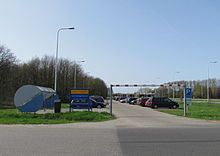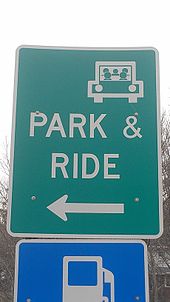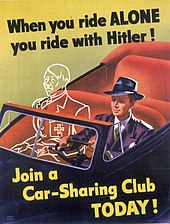
A high-occupancy vehicle lane is a restricted traffic lane reserved for the exclusive use of vehicles with a driver and at least one passenger, including carpools, vanpools, and transit buses. These restrictions may be only imposed during peak travel times or may apply at all times. There are different types of lanes: temporary or permanent lanes with concrete barriers, two-directional or reversible lanes, and exclusive, concurrent, or contraflow lanes working in peak periods.

Commuting is periodically recurring travel between one's place of residence and place of work or study, where the traveler, referred to as a commuter, leaves the boundary of their home community. Regarding occupation, it is also colloquially called the journey to work. By extension, it can sometimes be any regular or often repeated travel between locations, even when not work-related. The modes of travel, time taken and distance traveled in commuting varies widely across the globe. Most people in least-developed countries continue to walk to work. The cheapest method of commuting after walking is usually by bicycle, so this is common in low-income countries but is also increasingly practised by people in wealthier countries for environmental and health reasons. In middle-income countries, motorcycle commuting is very common.

Intermodal passenger transport, also called mixed-mode commuting, involves using two or more modes of transportation in a journey. Mixed-mode commuting is often used to combine the strengths of various transportation options. A major goal of modern intermodal passenger transport is to reduce dependence on the automobile as the major mode of ground transportation and increase use of public transport. To assist the traveller, various intermodal journey planners such as Rome2rio and Google Transit have been devised to help travellers plan and schedule their journey.

Slugging, also known as casual carpooling, is the practice of forming ad hoc, informal carpools for purposes of commuting, essentially a variation of ride-share commuting and hitchhiking. A driver picks up these non-paying passengers at key locations, as having these additional passengers means that the driver can qualify to use an HOV lane or enjoy toll reduction. While the practice is most common and most publicized in the congested Washington, D.C. metropolitan area, slugging also occurs in San Francisco, Houston, and other cities.
Vanpools or Vanpooling is an element of the transit system that allow groups of people to share the ride similar to a carpool, but on a larger scale with concurrent savings in fuel and vehicle operating costs and thus usually a lower cost to the rider. Vanpools have a lower operating and capital cost than most transit vehicles in the United States, but due to their relatively low capacity, vanpools often require subsidies comparable to conventional bus service.
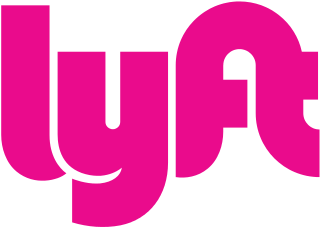
Lyft, Inc. is an American company offering mobility as a service, ride-hailing, vehicles for hire, motorized scooters, a bicycle-sharing system, rental cars, and food delivery in the United States and select cities in Canada. Lyft sets fares, which vary using a dynamic pricing model based on local supply and demand at the time of the booking and are quoted to the customer in advance, and receives a commission from each booking. Lyft is the second-largest ridesharing company in the United States after Uber.

John Zimmer is the co-founder and former president of Lyft, an on-demand transportation company, which he founded with Logan Green in 2012.

Shared transport or shared mobility is a transportation system where travelers share a vehicle either simultaneously as a group or over time as personal rental, and in the process share the cost of the journey, thus creating a hybrid between private vehicle use and mass or public transport. It is a transportation strategy that allows users to access transportation services on an as-needed basis. Shared mobility is an umbrella term that encompasses a variety of transportation modes including carsharing, Bicycle-sharing systems, ridesharing companies, carpools, and microtransit.

Zimride by Enterprise Holdings was an American carpool program that matched inter-city drivers and passengers through social networking services. It was offered to universities and businesses as a matchmaking service. The company was founded in May 2007. After the launch of the Lyft app in May 2012 for intra-city rides, the Lyft app rapidly grew and became the focus of the company. Zimride officially renamed as Lyft in May 2013, and the Zimride service was sold to Enterprise Holdings in July 2013. As of July 2013, the service had over 350,000 users and had partnerships with Facebook and Zipcar.

Carma Technology Corporation is a real-time transportation technology company headquartered in Cork, Ireland. Its flagship product, Carma Carpooling, matches users with nearby commuters and enables them to share the cost of driving. Carma also has offices in San Francisco, California and Austin, Texas.
Flexible carpooling is carpooling that is not arranged ahead of time, but instead makes use of designated meeting places. It seeks to replicate the informal "slug-lines" that form in Washington DC, Houston, and San Francisco, by establishing more formal locations for travelers to form carpools without advance contact.
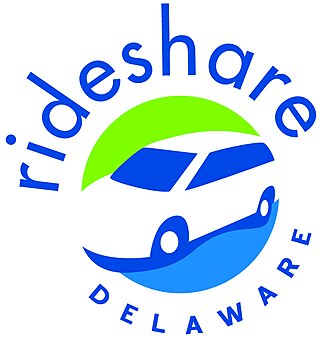
RideShare Delaware is DART First State's program to reduce traffic and encourage alternative transportation arrangements. The program is supported by state and federal funds as part of Delaware's efforts to maintain air quality. RideShare works in partnership with local and regional agencies towards meeting Federal Air Quality Standards. It helps form both carpools and vanpools. It also offers special programs for students and Delaware employers.
carpooling.com was a carpooling service that connected drivers and passengers so they can share a ride. It was Europe's largest carpooling network. In 2015, it was acquired and folded into BlaBlaCar.

Logan D. Green is the chairman and former CEO of Lyft, which he co-founded with John Zimmer in 2012. Lyft grew out of Zimride, a ride share company previously founded by the duo in 2007.
Sidecar was a US-based vehicle for hire company that provided transportation and delivery services. It was founded in 2011 in San Francisco and closed on December 31, 2015.

A ridesharing company is a company that, via websites and mobile apps, matches passengers with drivers of vehicles for hire that, unlike taxis, cannot legally be hailed from the street.
The legality of ridesharing companies by jurisdiction varies; in some areas they are considered to be illegal taxi operations, while in other areas, they are subject to regulations that can include requirements for driver background checks, fares, caps on the number of drivers in an area, insurance, licensing, and minimum wage.
BlaBlaCar is an online marketplace for carpooling headquartered in Paris. Its website and mobile apps connect drivers and passengers willing to travel together between cities and share the cost of the journey, in exchange for a commission of between 18% and 21%. It also operates BlaBlaBus, an intercity bus service. The platform has 26 million active members and is available Europe and Latin America.
Mobility as a service (MaaS) is a type of service that, through a joint digital channel, enables users to plan, book, and pay for multiple types of mobility services. The concept describes a shift away from personally-owned modes of transportation and towards mobility provided as a service. This is enabled by combining transportation services from public and private transportation providers through a unified gateway that creates and manages the trip, which users can pay for with a single account. Users can pay per trip or a monthly fee for a limited distance. The key concept behind MaaS is to offer travelers mobility solutions based on their travel needs.
Ride sharing networks face issues of user privacy like other online platforms do. Concerns surrounding the apps include the security of financial details, and privacy of personal details and location. Privacy concerns can also rise during the ride as some drivers choose to use passenger facing cameras for their own security. As the use of ride sharing services become more widespread so do the privacy issues associated with them.

